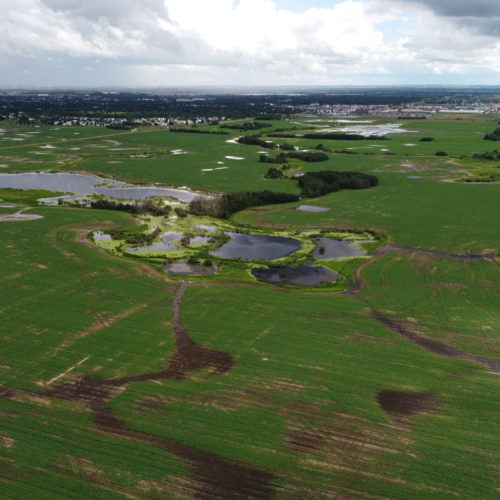The health of individuals and communities is interconnected with the health of the environment. The Environment, Community, Health Observatory (ECHO) Network was launched in 2017 to research and take action to improve the health of watersheds across Canada, with a particular focus on rural, remote, and Indigenous communities. ECHO is a partnership between researchers and local stakeholders (like us!), and together we better understand how resource development influences health, community wellbeing, and the environment.
Social-Ecological Resilience is the ability of our people, communities, wildlife, land, and water to be healthy and interact in a healthy way. When we understand how the health of our watershed is influenced by the ways we live, work, and play, we can take action. To move towards social-ecological resilience, we collaborated with the ECHO Network and the Alberta Centre for Sustainable Rural Communities to develop the Battle River Watershed Health Indicator Framework. This tool will help the BRWA assess the social, ecological and economic factors of health and wellbeing in the watershed and how they influence one another. The wheel consists of 6 main segments (inner circle) with specific measures and indicators nested within them (outer circle). Click here for the full, high-resolution version of the indicator framework.

The Watershed Health Indicator Framework was used to develop the Health in the Watershed Atlas, which is a next-generation state of the watershed report that paints a holistic picture of watershed health. With this broadened understanding, we hope to spark meaningful conversations about the actions we can all take to care for land, water, people, and communities in our watersheds.
As an Alberta Watershed Planning and Advisory Council (WPAC), an important role of the BRWA is to report on the health of the Battle River and Sounding Creek watersheds. See our 2011 State of the Watershed Report here. Since then, we’ve worked to broaden our understanding of watershed health by looking at (and striving to report on) the health of people, communities, ecosystems, and economies, which are all interconnected.
Humans rely on nature and ecosystem services for healthy air, water, soil, and shelter. Without these basic assets our economic and social activities like farming, generating energy, and recreating would be much more difficult, if not impossible!
Intact, well-functioning ecosystems shelter us from extreme events and their negative health impacts. Wetlands, for example, reduce the devastation of floods and droughts by storing excess water and releasing it slowly over time. Uncultivated, natural areas support larger bee populations which maximizes the productivity and profits of nearby agricultural crops. During heat waves in more densely populated areas, urban vegetation like trees, lawns, and even green roofs have the ability to reduce the urban heat island effect created by concrete and other impervious surfaces, keeping residents safe and cool.

Alberta could look warmer and stormier in the future with greater potential for both floods and droughts. Winter temperatures are not dipping down to the lows they have historically reached and shifts in the frequency, duration, and intensity of snow and rainfall are already having impacts on ecosystems and species distribution. Warmer average temperatures and expanded grasslands may be beneficial for species that are able to move easily, such as White-tailed Deer. However, some species may struggle to adapt without human intervention. For example, the ability of the endangered Sprague’s Pipit to move may be limited due to a lack of suitable habitat.
Some benefits may arise from changing climate patterns, such as longer frost-free growing seasons that could allow farmers to increase crop production and grow new types of crops. However, the drawbacks could also be significant. Of the 20 most damaging Canadian weather events since 1983, 12 of them occurred in Alberta. Along with the cost of damaged infrastructure and lost jobs, stressful events such as fires, floods, and droughts have significant negative impacts on people’s physical and mental health. Hotter temperatures may lead to increased cases of heat-related illness and asthma, and have also been linked to the spread of Lyme disease into new areas in Canada.
It is important, now more than ever, to protect natural landscapes while also ensuring people’s economic and social needs are met. The future holds challenges for natural and human systems, but opportunities will also arise.
The 1930s prairie dust bowl disaster, droughts of the 2000s, and flooding and hail events of recent years in central Alberta are all examples of Albertans recovering from poor environmental conditions. We now have a better understanding of how healthy ecosystems contribute to the health of our communities and economy. With this knowledge, we can be proactive in taking actions that support ecological health and reduce our risk and vulnerability to changing weather and climate patterns.

Climate solutions for resilient communities will involve a combination of mitigation and adaptation measures. Mitigation efforts aim to prevent the worst climate outcomes by curbing emissions and sequestering greenhouse gases. Adaptation measures identify risks and vulnerabilities to events like extreme weather, flooding, fire, heat waves, and drought, and then establish priorities, programs, emergency response plans, and infrastructure upgrades to address these risks. Across the prairie provinces, municipalities and Indigenous communities have been on the forefront of initiating and implementing adaptation measures.

Image retrieved from Chapter 4 in Canada in a Changing Climate: Regional Perspectives Report, 2020
Montana First Nation’s community-owned and operated solar energy company is an example of climate mitigation. It has delivered co-benefits of increased energy independence and ongoing local employment.
Adaptation measures differ depending on what risk is being addressed. Restoring wetlands and riverside areas through activities like planting stem cuttings helps us adapt to both flooding and drought by increasing natural water absorption capacity. Planting projects also provide direct benefits to farmers by creating windbreaks and building healthy soil.
What mitigation and adaptation measures will be important in the Battle River and Sounding Creek watersheds? Stay tuned!
Adaptation is not one-size-fits-all. Risk and vulnerability can vary from one municipality to another based on the local context and factors like geography, industry, existing infrastructure, and resident’s values. However, the BRWA is compiling climate data to provide a quick reference on what to expect from climate change and link you to helpful climate-related resources on future projections, risks, and mitigation and adaptation solutions in the Battle River and Sounding Creek watersheds.
The Environment, Community, Health Observatory Network (ECHO) sees the BRWA partnered with researchers and organizations from across Canada. The goal of this five-year project is to look into the links between the health of people, communities, and the environment. The ways in which we live, work, and play in our watershed can impact all of these things.
The ECHO Network is particularly interested in looking at how land uses such as oil and gas development, mining, agriculture, forestry, and other aspects of resource development shape our landscape and the health of people and communities. Rural, remote, and Indigenous communities will be important focus areas.
Once we understand how current practices are harming or helping our collective health, we can take action to make our watershed a healthier place for people, communities, wildlife, and the land and water on which we all depend.
Visit the ECHO Network for more information.